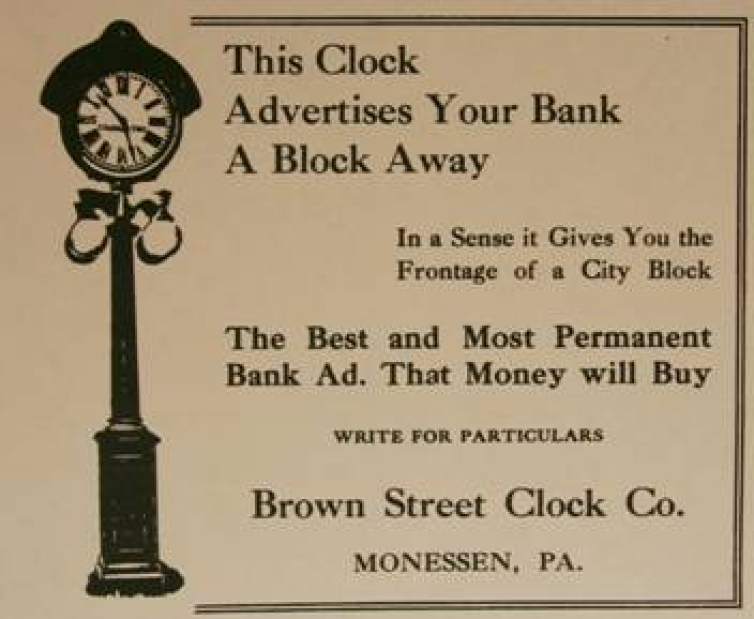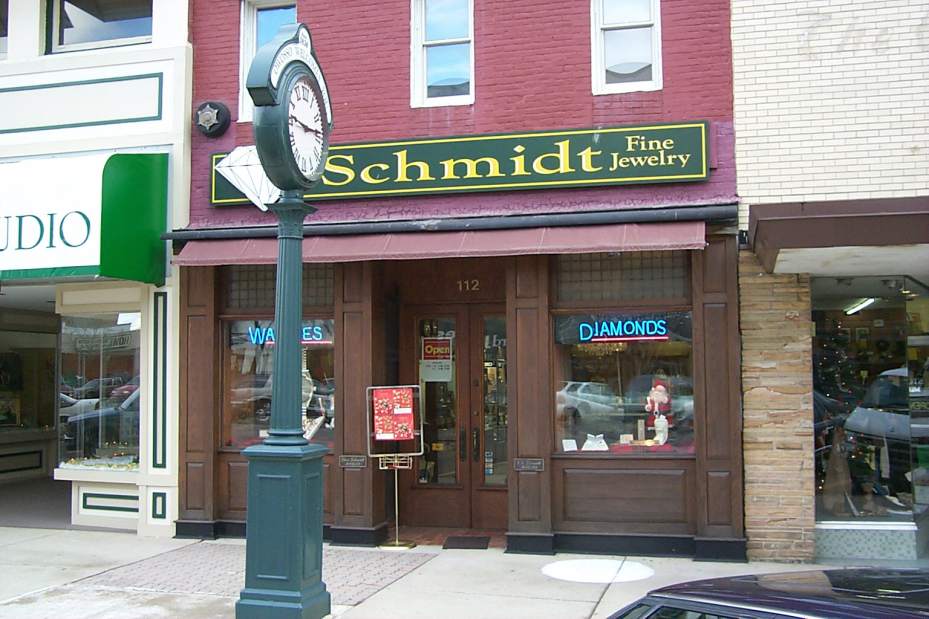Hometown deal on table, ticking for historic sidewalk timepiece
Monessen has a rare opportunity to turn back the clock to a some of its glory days.
That is, returning a Brown Street Clock to where it originated more than a century ago.
Don Bugh, a Texas collector, ran across one of the vintage street clocks manufactured by a city jeweler early last century and erected on Donner Avenue, where it stood for years in front of the long-defunct Monessen Savings & Trust Co.
He contacted Steve Schmidt, of Owosso, Mich., the current owner, who has it listed for sale on the Internet site, eBay, for $19,000.
Schmidt is willing to sell the antique Brown Street Clock, one of few remaining in the U.S., at a discounted price of $15,000 “to the City of Monessen, where it belongs” and to deliver it in person.
The cast-iron, lollipop-shape clock stands about 15 feet tall, contains the original gears and related mechanisms and, yes, it faithfully keeps accurate time.
“The clock is probably 100 years old and could last forever,” Schmidt said. “It's in excellent condition. All it needs is a little oil every now and then.”
He retired and closed his Owosso jewelry store where the clock has stood out front, on the sidewalk, for the past 20 or so years.
When Bugh found out Schmidt put the Brown Street Clock up for sale, he figured Monessen might be interested in order to preserve this piece of its history. The clocks were made and sold in Monessen, although actual assembly is believed to have taken place in Donora for a while.
Bugh contacted The Valley Independent to spread the word about the availability of the relatively rare find.
In addition, Bugh pledged to donate the first $500 to “any individual, company or organization willing to take on the challenge of organizing a fund-raising campaign to purchase and erect this clock.”
“So how about it, Monessen?” he wrote in an e-mail to the newspaper's managing editor, Bob Burke. “As they say, the clock is ticking.”
Bugh, chief financial officer of the Texas Transportation Institute, began collecting antique clocks long ago. More recently, he became interested in larger street clocks erected on sidewalks in an era preceding “personal timepieces” such as pocket watches.
His research showed that the Brown Street Clock Co. at 532 Donner Ave. was a major supplier of street clocks across the U.S. from approximately 1906 through the mid- to late-1920s.
Benjamin Brown, a jeweler and proprietor of the B.E. Brown Jewelry Store is believed to be the inventor-designer of the Brown Street Clock, advertised as “the best sign in the world to promote business.” The late R. Mitchell Steen, a Valley Independent editor who penned popular historical articles about the Mid-Mon Valley, chronicled the history of the ornate street clock company in 1996.
He wrote that Benjamin Brown began making the clocks in partnership with his brother, Walter Brown, also a jeweler, whose business was located at 669 McKean Ave. in Donora.
Steen reported that while most of the clocks were assembled in Donora, their internal “workings” came from Ben Brown's Monessen store, where the rear area was used as his warehouse.
The one-time Monessen Foundry made the ornate iron castings. Glass for the dual clock faces came from Pittsburgh Plate Glass Co.
While the partnership ended in 1911, Ben Brown operated the company until his death in December 1922, when his wife Berta and two sons continued the business until the plant closed several years later.
At one time, Bugh said, Brown Street Clocks “proudly stood in both Monessen and Donora.” The Donora clock came down after it was reportedly struck by a truck in 1967.
The elegant clocks eventually came to be considered sidewalk obstructions and began to slowly disappear, their heyday ending in the mid 20th century.
“(But) across the United States, at least 30 examples of Brown Street Clocks still exist,” Bugh said. “Sadly, none of these can be found in either Monessen of Donora.”
If a Monessen group were to acquire the clock as centerpiece of redevelopment, what happens if it breaks down?
Help is relatively nearby, Schmidt pointed out.
The National Association of Watch and Clock Collectors is headquartered in Columbia, Lancaster County. It operates a clock museum and trains people in the repair of vintage clocks such as the Browns Street Clock.
Schmidt visited both Monessen and Donora about 10 years ago, looking up the addresses where the Browns operated their jewelry stores and where their famous clocks were conceived.
“The towns seemed kind of depressed,” he said. “Maybe something like this will help pick them up.” During the period when street clocks were popular, the Brown Street Clock Co. was among four companies that dominated the national market. The others were the Seth Thomas Clock Co. of Thomaston, Conn.; the E. Howard Clock Co. of Boston, Mass.; and Joseph Mayer & Brothers of Seattle, Wash.
Joe Grata is a freelance writer from Washington Township.


